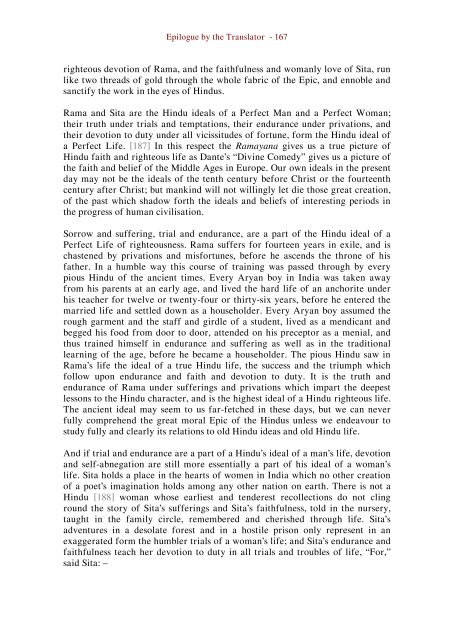Ramayana, Epic of Rama, Prince of India
An Abbreviated Translation of the Indian Classic, the Ramayana by Romesh Chundar Dutt in 2,000 verses
An Abbreviated Translation of the Indian Classic, the Ramayana by Romesh Chundar Dutt in 2,000 verses
Create successful ePaper yourself
Turn your PDF publications into a flip-book with our unique Google optimized e-Paper software.
Epilogue by the Translator - 167<br />
righteous devotion <strong>of</strong> <strong>Rama</strong>, and the faithfulness and womanly love <strong>of</strong> Sita, run<br />
like two threads <strong>of</strong> gold through the whole fabric <strong>of</strong> the <strong>Epic</strong>, and ennoble and<br />
sanctify the work in the eyes <strong>of</strong> Hindus.<br />
<strong>Rama</strong> and Sita are the Hindu ideals <strong>of</strong> a Perfect Man and a Perfect Woman;<br />
their truth under trials and temptations, their endurance under privations, and<br />
their devotion to duty under all vicissitudes <strong>of</strong> fortune, form the Hindu ideal <strong>of</strong><br />
a Perfect Life. [187] In this respect the <strong><strong>Rama</strong>yana</strong> gives us a true picture <strong>of</strong><br />
Hindu faith and righteous life as Dante’s “Divine Comedy” gives us a picture <strong>of</strong><br />
the faith and belief <strong>of</strong> the Middle Ages in Europe. Our own ideals in the present<br />
day may not be the ideals <strong>of</strong> the tenth century before Christ or the fourteenth<br />
century after Christ; but mankind will not willingly let die those great creation,<br />
<strong>of</strong> the past which shadow forth the ideals and beliefs <strong>of</strong> interesting periods in<br />
the progress <strong>of</strong> human civilisation.<br />
Sorrow and suffering, trial and endurance, are a part <strong>of</strong> the Hindu ideal <strong>of</strong> a<br />
Perfect Life <strong>of</strong> righteousness. <strong>Rama</strong> suffers for fourteen years in exile, and is<br />
chastened by privations and misfortunes, before he ascends the throne <strong>of</strong> his<br />
father. In a humble way this course <strong>of</strong> training was passed through by every<br />
pious Hindu <strong>of</strong> the ancient times. Every Aryan boy in <strong>India</strong> was taken away<br />
from his parents at an early age, and lived the hard life <strong>of</strong> an anchorite under<br />
his teacher for twelve or twenty-four or thirty-six years, before he entered the<br />
married life and settled down as a householder. Every Aryan boy assumed the<br />
rough garment and the staff and girdle <strong>of</strong> a student, lived as a mendicant and<br />
begged his food from door to door, attended on his preceptor as a menial, and<br />
thus trained himself in endurance and suffering as well as in the traditional<br />
learning <strong>of</strong> the age, before he became a householder. The pious Hindu saw in<br />
<strong>Rama</strong>’s life the ideal <strong>of</strong> a true Hindu life, the success and the triumph which<br />
follow upon endurance and faith and devotion to duty. It is the truth and<br />
endurance <strong>of</strong> <strong>Rama</strong> under sufferings and privations which impart the deepest<br />
lessons to the Hindu character, and is the highest ideal <strong>of</strong> a Hindu righteous life.<br />
The ancient ideal may seem to us far-fetched in these days, but we can never<br />
fully comprehend the great moral <strong>Epic</strong> <strong>of</strong> the Hindus unless we endeavour to<br />
study fully and clearly its relations to old Hindu ideas and old Hindu life.<br />
And if trial and endurance are a part <strong>of</strong> a Hindu’s ideal <strong>of</strong> a man’s life, devotion<br />
and self-abnegation are still more essentially a part <strong>of</strong> his ideal <strong>of</strong> a woman’s<br />
life. Sita holds a place in the hearts <strong>of</strong> women in <strong>India</strong> which no other creation<br />
<strong>of</strong> a poet’s imagination holds among any other nation on earth. There is not a<br />
Hindu [188] woman whose earliest and tenderest recollections do not cling<br />
round the story <strong>of</strong> Sita’s sufferings and Sita’s faithfulness, told in the nursery,<br />
taught in the family circle, remembered and cherished through life. Sita’s<br />
adventures in a desolate forest and in a hostile prison only represent in an<br />
exaggerated form the humbler trials <strong>of</strong> a woman’s life; and Sita’s endurance and<br />
faithfulness teach her devotion to duty in all trials and troubles <strong>of</strong> life, “For,”<br />
said Sita: –

















